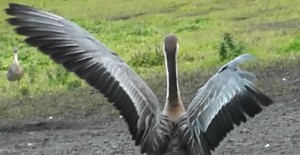 A recent report released by ENDCAP member, the Captive Animals’ Protection Society (CAPS) in the UK, has exposed the widely-practised, but little-talked about, practice of pinioning birds by zoos. Thousands of birds are deliberately maimed: permanently preventing their flight, in order to maintain their captivity, whilst “bringing people closer to wildlife”. ENDCAP joins CAPS in calling on the UK Government, and the wider European Community, to stop this barbaric practice.
A recent report released by ENDCAP member, the Captive Animals’ Protection Society (CAPS) in the UK, has exposed the widely-practised, but little-talked about, practice of pinioning birds by zoos. Thousands of birds are deliberately maimed: permanently preventing their flight, in order to maintain their captivity, whilst “bringing people closer to wildlife”. ENDCAP joins CAPS in calling on the UK Government, and the wider European Community, to stop this barbaric practice.
Pinioning involves “the cutting of one wing at the carpel joint, thereby removing the basis from which the primary feathers grow. This makes the bird permanently incapable of flight because it is lopsided[i]”. The practice is common on birds such as flamingos, storks and wildfowl in zoos, usually carried out when the birds are just a few days old, but renders them permanently disabled as a result of the partial amputation of one wing. An alternative to keeping birds in closed enclosures, zoos are then able to display their birds in a near-natural setting, but for the birds, they will never be able to experience flight again.
The CAPS report, “Mutilated for your viewing pleasure” has revealed than under UK law pinioning is classed as a “permitted mutilation”. The report reveals that at least 6,000 birds in UK zoos have been subjected to the practice but concedes that this figure is likely to be much higher, given the small sample of zoos considered during the study.
Liz Tyson, CAPS Director said, “The report offers just the tip of the iceberg in terms of numbers of birds who have had their wings partially amputated by zoos. The vast majority of species and individuals that have been disabled in this way are not threatened in the wild so there is no possible argument that this is being done for conservation purposes. If the zoo industry was amputating the paws of tigers or the legs of giraffes, it would never be accepted. This has gone on for too long – no animal should ever be subjected to the removal of part of a limb simply so that they can be more easily and cheaply exhibited to zoo visitors”.
The zoo industry has stated that the pinioning of birds prevents the escape of birds into the natural environment, provides a cost-effective alternative to large flight aviaries, and “brings people closer to wildlife”.
Denouncing these claims, ENDCAP and CAPS are calling for an end to the practice and argues that the only humane solution is to put an end to keeping these birds in captivity. ENDCAP will be calling on the European Parliament to urge Member States and the Commission to ban pinioning, joining countries such as Estonia, Italy, the Netherlands, Norway, Switzerland and Kazakhstan[ii] that already prohibit the practice.
Notes to Editors:
Contact:
Captive Animals Protection Society – Liz Tyson (Director) or Kat Affleck (Campaigns Officer)
Further reading:
For more details on the campaign, copies of the report and information on the wider study commissioned by CAPS into the keeping of birds in zoos, please visit www.captiveanimals.org/birds
[i] Rees, P.A. 2011. An Introduction to Zoo Biology and Management. Wiley-Blackwell, 2011
[ii] Cranswick, P. & Hall, C. 2010. Eradication of the Ruddy Duck Oxyura jamaicensis in the Western Palaearctic: a review of progress and a revised Action Plan 2010–2015. WWT report to the Bern Convention. Wildfowl and Wetlands Trust.
More about zoos and aquaria
01Apr2013

